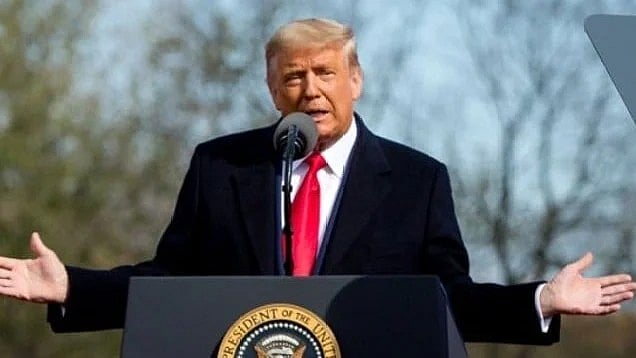
US President Donald Trump
Credit: X@realDonaldTrump
The latest announcement by US President Trump to levy the steepest, ‘unkindest’ 25% tariff on imports from India coupled with an unspecified ‘penalty’ for India purchasing crude oil from and its defence ties with Russia is a clear indication that the trade war has taken a geopolitical turn.
The draconian 25% tariff comes into effect from August 7, 2025 with a silver lining that goods which are already in transit / shipment will only attract the base line tariff of 10% and not the latest levy of 25%.
The 25% tariff plus penalty announcement will unsettle the economy, market, create sectoral imbalances only in the short term, for the following reasons :
The effective tariff rate works out to 20.7% even with the levy of 25% tariff (presently 11.7%).
The GDP impact can be around 0.3% in FY26 which can be compensated, as ours is a huge consumption economy and need not budge to Trump’s tantrums.
Assuming that the 25% tariff is implemented (which will get reduced in September/ October) the worst sufferers will be the people of America whose household expenses will skyrocket by over $2000 with Trump’s tariff trauma levied across 70 countries.
The increase in domestic prices in the US will have cascading effect leading to higher inflation, low demand, more layoffs from stores / retail outlets, dollar devaluation, possible recession, which will eventually backfire on Trump’s grandiose dream of MAGA (Making America Great Again) and the pipedream of wiping of the humongous accumulated US debt.
Moreover, the 25% tariff threat has few exclusions for exports from India to the US, as of now. Export of pharma drugs (generic), semiconductors, electronic products including smart phones are excluded from the 25% tariff tirade.
IT sector, as it is ‘service based’ and not ‘physical exports’, will not bear a direct brunt but can have collateral damages in the form of reduced global orders which in turn can have ripple-effect on hiring, layoffs and job losses.
Real estate and banking will be least hurt by the tariff but our domestic market will be hit by reduced foreign direct investment (FDI) from the US which is quite high now. However, 30-40% of micro small & medium enterprises (MSMEs), which are mostly export oriented, will be subjected to margin pressure, price hikes, adverse cost to benefit, banks shying away from lending. This will, in turn, affect the asset quality in the MSME sector which is presently quite robust.
So, basically it is not the Trump tariff threat which should bother us, as of now. It is the loss of trust and the bonhomie which Trump displayed during Prime Minister Narendra Modi’s visits to US and the warmth which President Trump received when he visited India / Ahmedabad. It is quite clear now that Trump’s show of affection and warmth is only for the optics.
President Trump has issues with India’s growth story and India gradually becoming an economic super power with its leanings towards Russia and also towards China, to some extent. The frustration can easily be deciphered from his recent remarks posted on Truth Social “I don’t care what India does with Russia. They can take their dead economies down together, for all I care”. This is unbecoming of his stature as the President of USA.
The frustration is also due to India having ties with Russia for defence purchases (to keep the eggs in different baskets!) and procuring crude oil from Russia which has cost advantage to us for which the ‘head master’ Trump is threatening the undisclosed penalty as a punishment.
The serious back door parleys with our ministerial delegations led by Piyush Goyal and External Affairs Minister Jai Shankar were inconclusive. The Bilateral Trade Agreement (BTA) could not be inked before the August 1 deadline.
The main reasons for the deadlock was India not compromising and crossing the ‘Lakshman Rekha’ on 3 specific issues - opening of our agriculture and dairy sectors to the US imports which will cause harm to our farmers and allied sectors, purchase of oil from Russia will be purely based on cost / benefit advantages and defence/arms purchases from Russia is a strategic decision in the best interest of the country and India cannot be arm twisted on these critical and sensitive grounds.
Narendra Modi’s silence to Trump’s uncharitable utterances has displayed maturity, diplomacy and highest level of statesmanship.
The sixth round of deliberations between India and the US on the BTA and on the 25% tariff issue will commence from August 25, 2025. India’s policy response should be a well calibrated, structured one, with some relaxations conceded in the ‘auto sector’, liquor imports as we cannot ignore the $80 billion India’s exports to US with a trade surplus of around $40 billion. With certain give and take formula, the 25% tariff is bound to come down to the level of at least to the tariff rates of peer and neighbouring countries in the range of 15 - 20%.